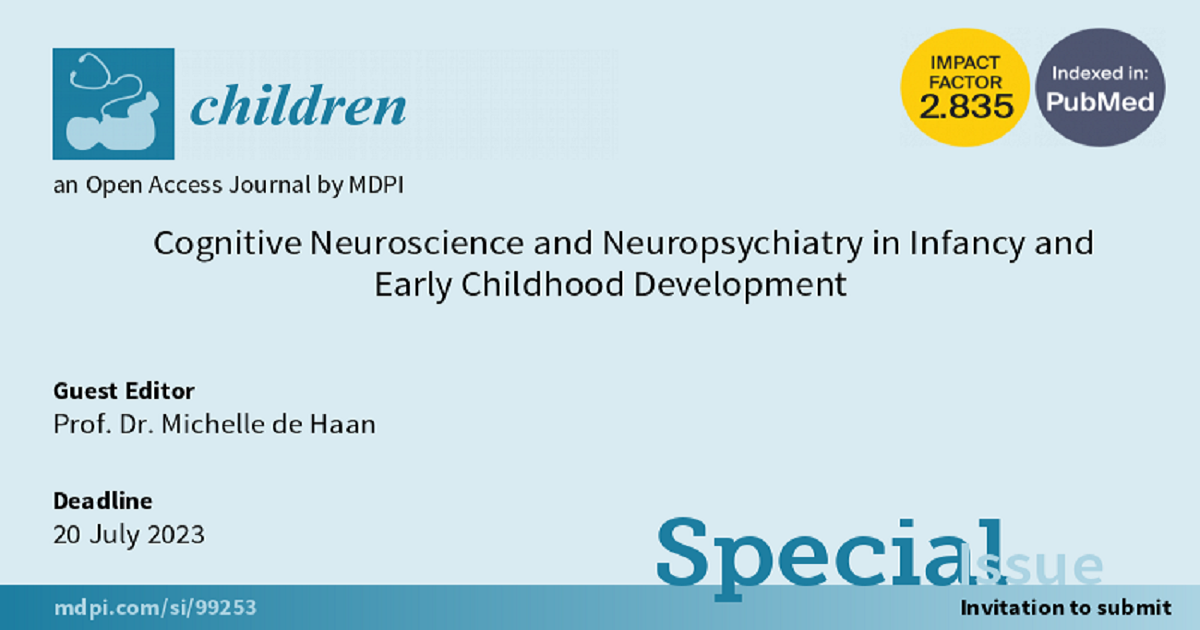- 2.1Impact Factor
- 3.8CiteScore
- 16 daysTime to First Decision
Cognitive Neuroscience and Neuropsychiatry in Infancy and Early Childhood Development
This special issue belongs to the section “Pediatric Neurology & Neurodevelopmental Disorders“.
Special Issue Information
Dear Colleagues,
Neuropsychological evaluation and neuroimaging techniques are used to understand the pattern of brain-related strengths and weaknesses in various neurodevelopmental conditions to understand the origin of the problems, make a diagnosis, and guide interventions and treatment. We would like to invite you to contribute to this Special Issue on Cognitive Neuroscience and Neuropsychiatry in Infancy and Early Childhood Development in Children. The aim is to collect articles that focus on the following areas: (1) neurophysiology, (2) sickle cell disease, (3) visual impairment, (4) infant-onset epilepsy, (5) preterm birth, and (6) cognitive development and social development. We welcome submissions from global health settings.
Our goal for this issue is to collect recent empirical studies to provide an up-to-date overview and an extension of the state of research. Paediatric Neuropsychology and neuroimaging are key areas to understand development in early years. We therefore welcome studies that identify new approaches in the diagnosis, prevention, or intervention for children within the realm of Cognitive Neuroscience and Neuropsychiatry in infancy and early childhood years. All types of manuscripts, such as research papers and reviews, are welcome.
Prof. Dr. Michelle de Haan
Guest Editor
Manuscript Submission Information
Manuscripts should be submitted online at www.mdpi.com by registering and logging in to this website. Once you are registered, click here to go to the submission form. Manuscripts can be submitted until the deadline. All submissions that pass pre-check are peer-reviewed. Accepted papers will be published continuously in the journal (as soon as accepted) and will be listed together on the special issue website. Research articles, review articles as well as short communications are invited. For planned papers, a title and short abstract (about 250 words) can be sent to the Editorial Office for assessment.
Submitted manuscripts should not have been published previously, nor be under consideration for publication elsewhere (except conference proceedings papers). All manuscripts are thoroughly refereed through a single-blind peer-review process. A guide for authors and other relevant information for submission of manuscripts is available on the Instructions for Authors page. Children is an international peer-reviewed open access monthly journal published by MDPI.
Please visit the Instructions for Authors page before submitting a manuscript. The Article Processing Charge (APC) for publication in this open access journal is 2400 CHF (Swiss Francs). Submitted papers should be well formatted and use good English. Authors may use MDPI's English editing service prior to publication or during author revisions.
Keywords
- paediatric neuropsychology
- neurosciences
- epilepsy
- cognitive, development
- brain imaging
- preterm
- social development
- infants
- preschoolers
- toddlers
- paediatric neurophysiology
- paediatric neuroimaging

Benefits of Publishing in a Special Issue
- Ease of navigation: Grouping papers by topic helps scholars navigate broad scope journals more efficiently.
- Greater discoverability: Special Issues support the reach and impact of scientific research. Articles in Special Issues are more discoverable and cited more frequently.
- Expansion of research network: Special Issues facilitate connections among authors, fostering scientific collaborations.
- External promotion: Articles in Special Issues are often promoted through the journal's social media, increasing their visibility.
- e-Book format: Special Issues with more than 10 articles can be published as dedicated e-books, ensuring wide and rapid dissemination.

